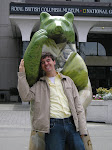The Great Noise Ensemble is among the most exciting and ambitious new music ensembles in Washington, D.C. Their May 18 concert at the National Gallery of Art marked a strong finish to their third season.
Things started off with Barbara White's quirky and cute Learning to See. While most of the score garnered some level of interest, there were moments of real shimmer, like the bowed vibraphone tones that morphed into held tones of other instruments. Such orchestrational touches are always a welcome sign of a composer who has put some real thought into the details of her/his music.
Rothko-Tobery Continuum by Evan Chambers offered a sincere approach to electro-acoustic music, showing a solid sense of balance in content between its electronic and acoustic forces. Violinist Heather Figi played the largely tonal violin part with a healthy Romantic flair, while the speaker contributed a surprisingly varied and expressive synthesized orchestral sound (for work generated in 1992!). The beautiful marriage of content, however, was marred slightly by a too-quiet speaker.
Andrew Rudin was programed on Great Noise's first public concert back in 2006, and this success earned him another performance - this time of a work written specifically for Great Noise, his Concerto for Piano and Small Orchestra. Rudin's mature writing was immediately evident in the length of his musical "chunks," presenting material for about 2-3 minutes before contrasting or drastically developing his thoughts. He seemed always to ride slightly ahead of my critiques. Just as I started to feel that he needed to increase the harmonic interest, he threw in a deliciously dissonant, emotive, pianistic cadenza. Just as the rhythms of the ensemble-driven second movement were in danger of becoming too ingrained, his music winked with some coy quintuplets and other variations.
Not afraid to please the listener, Rudin used rich tertian harmonies and frequent major sevenths that would mingle well with jazz and early twentieth-century sound worlds, as would the flashes of irregular meter and non-functional harmonies. The self-described "jovial" and "tongue-in-cheek" third movement brought virtuosic pianist Marcantonio Barone to the forefront again. A driving pulse was passed among various sections, leading to an impressive, muscular final cadenza and a brief, powerful whack of an ending. I would certainly pay to hear this work again.
A quick note on concert etiquette: do not change seats, snore, shuffle around, leave the room, or - worst of all - hold audible discussions during a live performance. That is all. (I hope the concert recording is salvageable.)
Low, dark colors were explored in a quintet by Great Noise tuba player Blair Goins. The bassoon and cello lent the piece a deep sound that only occasionally overpowered the violin, clarinet, and flute. The busy texture and prevalence of tertian planing made the listening experience refreshingly light and natural. Goins certainly showed an experienced sense of ensemble interplay as solos and duets were carefully balanced with full-ensemble sections. The textures of the first two movements, however, were a tad too similar to hold interest. The individual voices of the third movement were handled very well and complimented each other nicely, particularly the interesting accompanimental pairing of cello and low-range clarinet.
Great Noise director Armando Bayolo's Chamber Symhpony ("Illusory Airs") closed out the concert on a high note. The piece's largely sectional form, featuring somewhat abrupt alternations of dissimilar material, allowed Bayolo to extend his musical thoughts throughout entire coherent movements without falling into predictable patterns. The dark four-note opening theme formed an effective musical landmark that held sway even through to its return in the third movement.
Textural variety abounded through plodding quarter notes, intense rhythmic activity, and high , rapid figurations reminiscent of early Stravinsky. Use of the "rhythm section" in the second movement (piano, guitar and percussion) was timed expertly, with hits placed close enough to keep the listener's attention but far enough apart to avoid becoming tiresome. Bayolo demonstrated his careful ear for ensemble balance, especially in subdued moments with the guitar - a notoriously quiet instrument.
The work's final movement chugged along aggressively for a short while in irregular meters, followed by another drastic texture change. Most of the ensemble dropped out while the steady sixteenth-note pulse continued to lay a foundation for solo melodies. While much of the third movement was sufficiently intense to earn its place in a closing movement, Bayolo craftily conserved enough power for the closing to deliver a real kick. This final build-up truly gave the audience what it was waiting for - an exciting and almost optimistic rhythmic drive that lured the ear in, leading up to the moment in which the dark melodic fragment from the first movement mingled with and overpowered the existing brighter texture, producing that odd sense of "tense joy" so clearly explained in Bayolo's conception of the piece. The psychological fulfillment of such a nebulous, subjective goal through purely musical means was truly an impressive feat and a sign of both an experienced and exciting composer and a skilled, dedicated, tight ensemble.
Be on the lookout for future performances of Armando Bayolo's Chamber Symphony. This composition, like the ensemble that brought it into life, truly delivers on its ambitious promises.
Monday, May 19, 2008
Review: Great Noise Ensemble at National Gallery
Labels:
chamber music,
contemporary music,
dc,
great noise ensemble,
reviews
Subscribe to:
Post Comments (Atom)


Did people really do ALL of those things in the audience??
ReplyDeleteYes, although interestingly, this was not the first time I've experienced this at a Great Noise concert.
ReplyDeleteI think we were just sitting in a bad spot in the audience.